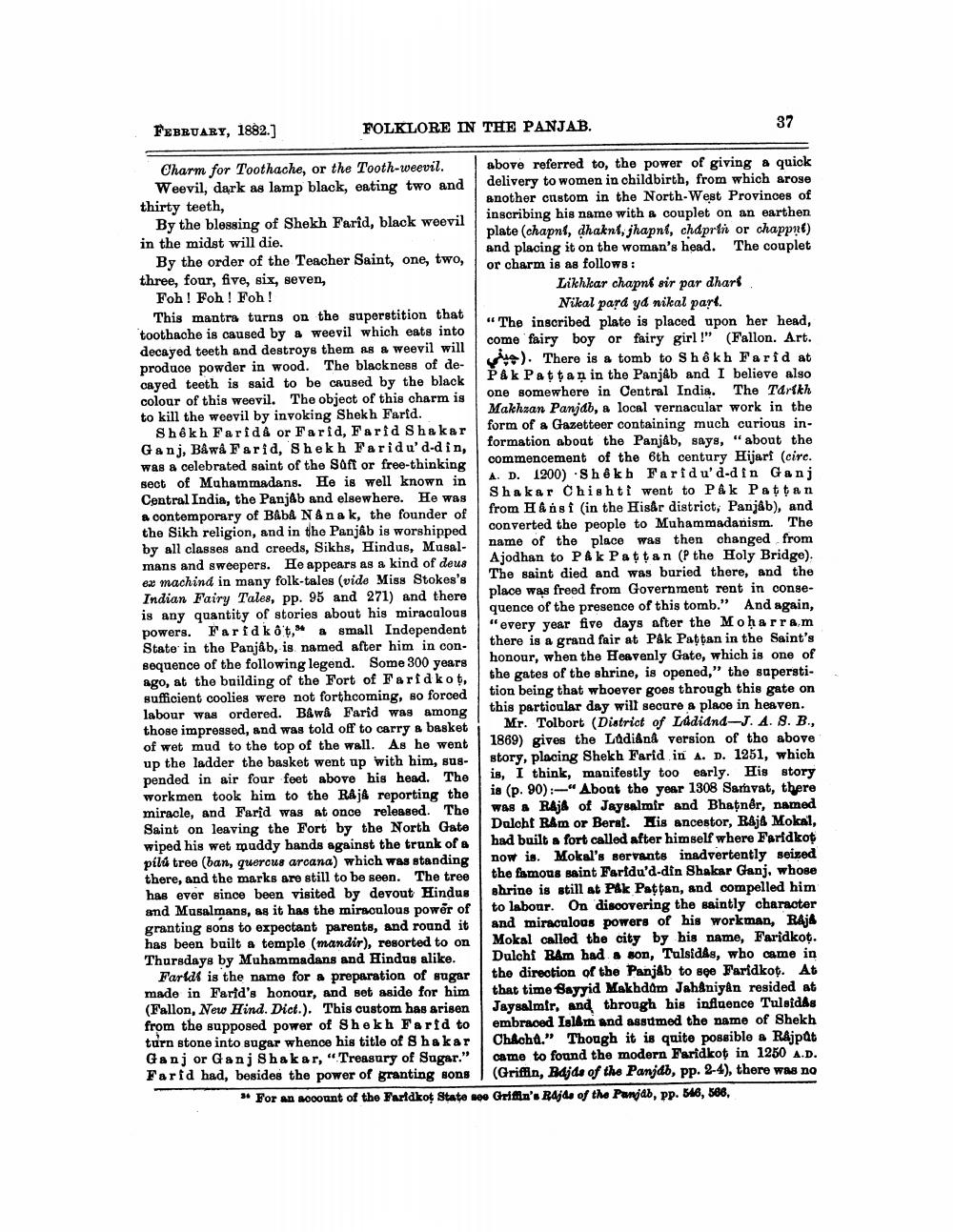________________
FEBRUARY, 1882.]
FOLKLORE IN THE PANJAB.
37
Charm for Toothache, or the Tooth-weevil. above referred to, the power of giving a quick Weevil, dark as lamp black, eating two and delivery to women in childbirth, from which arose thirty teeth,
another custom in the North-West Provinces of By the blessing of Shekh Farid, black weevil
inscribing his name with a couplet on an earthen
plate (chapni, dhakni, jhapni, chdprin or chapprt) in the midst will die.
and placing it on the woman's head. The couplet By the order of the Teacher Saint, one, two,
or charm is as follows: three, four, five, sis, seven,
Likhkar chapni sir par dhar Foh! Foh! Foh!
Nikal para yd nikal part. This mantra turns on the superstition that
"The inscribed plate is placed upon her head, toothache is caused by a weevil which eats into
como fairy boy or fairy girl!" decayed teeth and destroys them as a weevil will
(Fallon. Art. produce powder in wood. The blackness of de
wise). There is a tomb to Shekh Farid at cayed teeth is said to be caused by the black
Pak Pattan in the Panjáb and I believe also colour of this weevil. The object of this charm is
one somewhere in Central India. The Tarikh to kill the weevil by invoking Shekh Farid.
Makhaan Panjdb, a local vernacular work in the Shekh Farida or Farid, Farid Shakar
form of a Gazetteer containing much curious inGanj, Båwå Farid, Shekh Faridu'd-din, formation about the Panjab, says, "about the was a celebrated saint of the Saft or free-thinking commencement of the 6th century Hijari (cire. sect of Muhammadans. He is well known in A. D. 1200) Shekh Farid u'd-din Ganj Central India, the Panjab and elsewhere. He was
Shakar Chishti went to Pak Pattan a contemporary of BâbA N & na k, the founder of
from H&nsi (in the Hisêr district, Panjab), and the Sikh religion, and in the Panjab is worshipped
converted the people to Muhammadanism. The by all classes and creeds, Sikhs, Hindus, Musal- name of the place was then changed from mans and sweepers. He appears as a kind of deus
Ajodhan to Pak Pattan (P the Holy Bridge) ex machind in many folk-tales (vido Miss Stokes's
The saint died and was buried there, and the Indian Fairy Tales, pp. 95 and 271) and there place was freed from Government rent in congeis any quantity of stories about his miraculous
quence of the presence of this tomb." And again, powers. Faridkot, a small Independent
"every year five days after the Moharram State in the Panjab, is named after him in con
there is a grand fair at Pak Pattan in the Saint's sequence of the following legend. Some 300 years
honour, when the Heavenly Gate, which is one of ago, at the building of the Fort of Faridkot, the gates of the shrine, is opened," the superstisufficient coolies were not forthcoming, so forced
tion being that whoever goes through this gate on labour was ordered. Båwå Farid was among
this particular day will secure a place in heaven. those impressed, and was told off to carry a basket
Mr. Tolbort (District of Ladidnd-J. A. S. B., of wet mud to the top of the wall. As he went 1869) gives the Ladiêng version of tho above up the ladder the basket went up with him, sus- story, placing Shekh Farid in A. D. 1251, which pended in air four feet above his head. The is, I think, manifestly too early. His story workmen took him to the Raja reporting the
is (p. 90):-"About the year 1308 Samvat, there miracle, and Farid was at once released. The was a Rajø of Jaysalmir and Bhatnêr, named Saint on leaving the Fort by the North Gate Duloht Ram or Berat. His ancestor, Raja Mokal, wiped his wet muddy hands against the trunk of s had built a fort called after himself where Faridkot pílá tree (ban, quercus arcana) which was standing now is. Mokal's servants inadvertently seized there, and the marks are still to be seen. The tree the famous saint Feridu'd-din Shakar Ganj, whose has ever since been visited by devout Hindus shrine is still at Påk Pattan, and compelled him and Masalmans, as it has the miraculous power of to labour. On discovering the saintly character granting sons to expectant parents, and round it and miraculous powers of his workman, RAA has been built a temple (mandir), resorted to on Mokal called the city by his name, Faridkot. Thursdays by Muhammadans and Hindus alike. Dulchf Ram had a son, Tulsidas, who came in
Faridi is the name for a preparation of sugar the direction of the Panjab to see Faridkot. At made in Farld's honour, and set aside for him that time tayyid Makhdom Jahaniyan resided at (Fallon, New Hind. Dict.). This custom has arisen Jaysalmir, and through his influence Tulsidas from the supposed power of Shekh Farid to embraced Islam and assumed the name of Shekh turn stone into sugar whence his title of Shakar Chacht." Though it is quite possible a Rajpat Ganj or Ganj Shakar, “Treasury of Sugar." came to found the modern Faridkot in 1250 A.D. Farid had, besides the power of granting sons (Griffin, Bdjde of the Panjdb, pp. 2-4), there was no
* For an account of the Faridkot State nee Griffin's Bajde of the Panjab, pp. 546, 506,




